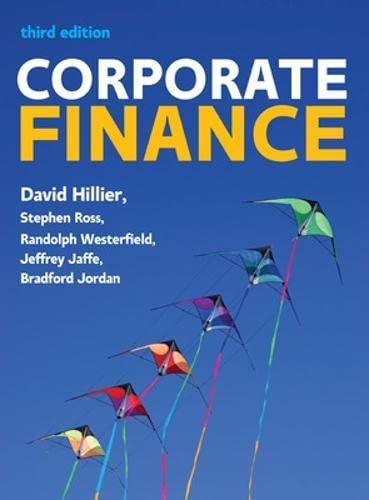This is a comprehensive project evaluation problem bringing together much of what you have learned in this
Question:
This is a comprehensive project evaluation problem bringing together much of what you have learned in this and previous chapters. Suppose you have been hired as a financial consultant to Defence Electronics International (DEI), a large, publicly traded firm that is the market share leader in radar detection systems (RDSs). The company is looking at setting up a manufacturing plant overseas to produce a new line of RDSs. This will be a 5-
year project. The company bought some land three years ago for £7 million in anticipation of using it as a toxic dump site for waste chemicals, but it built a piping system to safely discard the chemicals instead. If the company sold the land today, it would receive £6.5 million after taxes. In 5 years the land can be sold for £4.5 million after taxes and reclamation costs. The company wants to build its new manufacturing plant on this land; the plant will cost £15 million to build. The following market data on DEI’s securities are current:

DEI’s tax rate is 28 per cent. The project requires £900,000 in initial net working capital investment to become operational.
(a) Calculate the project’s initial time 0 cash flow, taking into account all side effects.
(b) The new RDS project is somewhat riskier than a typical project for DEI, primarily because the plant is being located overseas. Management has told you to use an adjustment factor of + 2 per cent to account for this increased riskiness. Calculate the appropriate discount rate to use when evaluating DEI’s project.
(c) The manufacturing plant has an 8-year tax life, and DEI uses 20 per cent reducing balance depreciation for the plant. At the end of the project (i.e., the end of year 5), the plant can be scrapped for £5 million. What is the after-tax salvage value of this manufacturing plant?
(d) The company will incur £400,000 in annual fixed costs. The plan is to manufacture 12,000 RDSs per year and sell them at £10,000 per machine; the variable production costs are £9,000 per RDS. What is the annual operating cash flow (OCF) from this project?
(e) DEI’s comptroller is primarily interested in the impact of DEI’s investments on the bottom line of reported accounting statements. What will you tell her is the accounting break-even quantity of RDSs sold for this project?
(f) Finally, DEI’s president wants you to throw all your calculations, assumptions and everything else into the report for the chief financial officer; all he wants to know is the RDS project’s internal rate of return, IRR, and net present value, NPV. What will you report?
Step by Step Answer:

Corporate Finance
ISBN: 9780077173630
3rd Edition
Authors: David Hillier, Stephen A. Ross, Randolph W. Westerfield, Bradford D. Jordan, Jeffrey F. Jaffe





